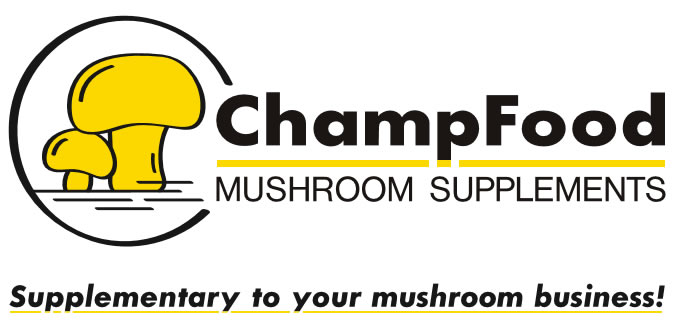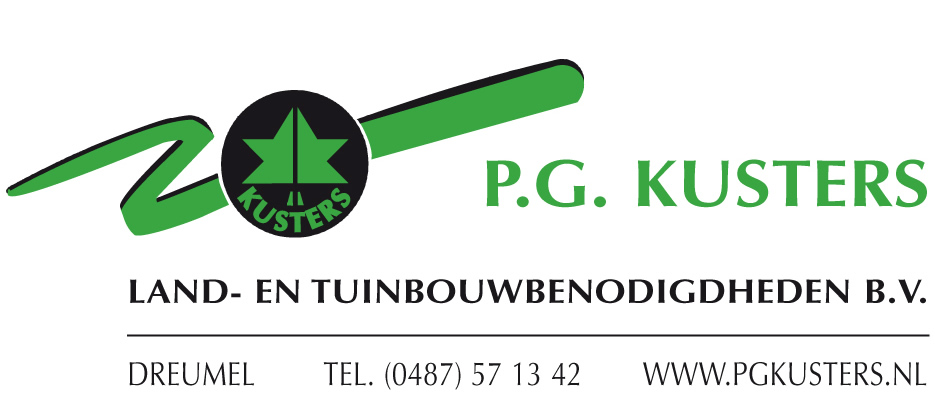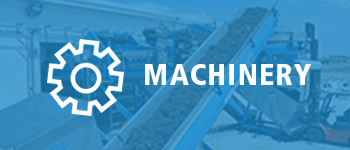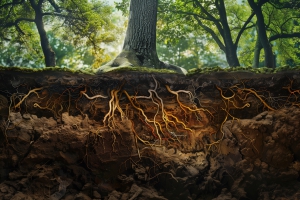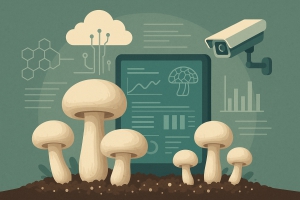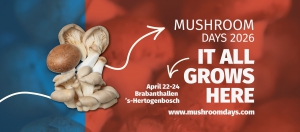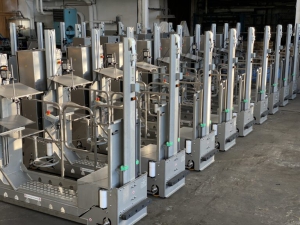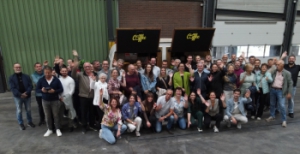
Mushroom Matter
Welcome on our platform. Why MUSHROOM MATTER? Because mushrooms play an important role in our lives as well in business. Our goal is to bring the world the very latest mushroom news with the upmost care to support the positioning of our beloved Mushroom.
Latest newsletter
Stay connected,discover the latest in the mushroom industry
Our newsletters bring the world of mushrooms straight to your inbox, from the latest innovations and technologies to inspiring stories and sustainable solutions. Every month, thousands of readers, growers, suppliers, researchers, and enthusiasts from across the globe, stay informed through Mushroom Matter.
Not yet subscribed?
Stay ahead of the curve and never miss an update on trends, insights, and stories from the mushroom world.
Share your story, innovation or brand
Would you like to position your company, product, or research in front of an international audience?
Our platform offers global visibility through::
-
Monthly newsletters reaching professionals across the mushroom value chain
-
Sponsored articles and advertorials that highlight your expertise
-
News placements about your company’s latest developments or innovations
-
Website banners and packages tailored to your goals
Advertising with Mushroom Matter means being part of a community that values quality, innovation, and connection within the global mushroom industry.
Together we make the mushroom world grow and matter
At Mushroom Matter, we believe in sharing knowledge, inspiring innovation, and connecting people who care about the future of fungi. Whether you want to read, share, or advertise, this is your gateway to a growing global network.
If you remove the mushroom, nature falls apart
We often think of mushrooms as the visible fruit of a hidden world. A delicacy, a medicine, or simply a curiosity popping up after the rain. But beneath every mushroom lies an unseen network that is nothing less than the foundation of life on Earth. Remove the mushroom and nature, as we know it, begins to fall apart.
The hidden network beneath our feet
Every forest, meadow, and even your backyard soil hides a dense web of fungal threads called mycelium. This living network connects plants, trees, and microorganisms in an intricate underground communication system. It transports water, nutrients, and information, a kind of “wood wide web” that sustains entire ecosystems.
Without fungi, plants would struggle to grow. In fact, more than 90% of all plant species depend on a partnership with fungi known as mycorrhiza. These fungi attach to plant roots, exchanging minerals and moisture for sugars and carbon. It’s a perfect example of nature’s collaboration and without it, most forests would collapse.
The great recyclers
Fungi are the world’s ultimate recyclers. They decompose dead trees, fallen leaves, and animal remains, breaking down complex materials into nutrients that can be reused by other organisms. Without this process, forests would be buried under layers of organic waste, and the soil would become sterile.
In essence, fungi close the circle of life. When we remove them through soil degradation, chemical overuse, or deforestation, we break that natural recycling system. Nutrients stop flowing, and biodiversity declines.
An unsung climate ally
Fungi don’t just support plants — they also store massive amounts of carbon underground. Mycorrhizal fungi capture carbon from plant roots and lock it into the soil for decades or even centuries. Destroying fungal networks not only weakens plant life but also releases stored carbon back into the atmosphere, accelerating climate change.
The mushroom’s message
Mushrooms are the tip of a vast, intelligent system that has quietly sustained life for over a billion years. They are nature’s architects, caretakers and messengers, indicators of ecosystem health. When mushrooms disappear, it’s not just a culinary loss; it’s a warning sign that our environment is out of balance.
Protecting fungi means protecting life itself. Healthy soil, resilient forests, clean air, and even the food we eat all depend on the unseen world beneath our feet. So next time you see a mushroom in the wild, take a closer look. It’s not just a fungus, it’s a lifeline.
How do you see the role of fungi in the future of a healthier planet? We’d love to hear your thoughts, so drop us a line below!
The mushroom industry has always been an example of how biology and ingenuity can coexist. What started centuries ago as a craft based on observation, experience, and intuition is now rapidly evolving into a field where data and digital technology drive every decision. The next generation of mushroom farms is taking shape, intelligent, connected, and remarkably sustainable.
Automation becomes accessible
Until recently, automation was something only large farms could afford. Complex climate control systems, robotic picking solutions, and data-driven monitoring platforms were impressive but often out of reach for smaller growers. That landscape is now changing. As technology becomes more affordable and modular, small and mid-sized farms can adopt automation step by step, from simple environmental sensors to cloud-based farm management systems.
These tools help growers maintain stable growing conditions, reduce labor costs, and minimize waste. More importantly, they allow farmers to focus on the art of cultivation, rather than on manual data collection or repetitive control adjustments.
Smarter growing through data
Every mushroom tells a story of temperature, humidity, substrate composition, and microbial balance. By collecting and interpreting this data, growers can now understand their crops better than ever before. Artificial intelligence (AI) is entering the scene, helping to predict yields, identify anomalies early, and even recommend optimal growing cycles.
Imagine a system that learns the behavior of your farm, adjusting CO₂ levels, light exposure, or irrigation based on previous flushes while alerting you to subtle changes that might affect productivity. That’s not science fiction anymore; it’s the emerging reality of smart mushroom cultivation.
The rise of AI-assisted strain development
While climate control and automation enhance the growing environment, artificial intelligence could soon reshape what we grow. AI-assisted strain selection combines genomic data, performance tracking, and environmental inputs to identify which varieties thrive under specific conditions. This opens the door to developing new strains faster, with higher yields, better shelf life, or specific nutritional or medicinal properties.
For mushroom breeders and spawn producers, this digital layer adds precision to what has long been an art form, bridging traditional mycology with computational biology.
Transparency and traceability through blockchain
Consumers today want to know where their food comes from and mushrooms are no exception. Blockchain technology can bring new levels of transparency to the supply chain. From substrate sourcing to post-harvest logistics, each step could be securely logged, offering proof of sustainability, origin, and quality.
For growers, it’s also a way to build trust with buyers and regulatory bodies, simplifying certification and export documentation. In a world where sustainability is not just a value but a requirement, such traceability systems will likely become standard practice.
Sustainability: the core of innovation
At the heart of all this progress is a shared commitment to sustainability. Automation and digitalization are not replacing the grower, they’re empowering them to produce more efficiently, use fewer resources, and reduce waste. From optimizing substrate recipes to recycling heat and water within facilities, smart systems are helping farms close the loop.
The mushroom sector has always been a pioneer in circular agriculture. Now, by integrating technology, it is showing that environmental responsibility and innovation can grow side by side.
A future rooted in tradition and technology
The message is clear: the future of mushroom farming is intelligent, data-driven, and sustainable. Yet the essence of the craft remains unchanged, understanding living organisms and creating the conditions for them to thrive. By combining centuries-old cultivation wisdom with 21st-century technology, the mushroom industry continues to prove that innovation grows best on a fertile foundation.
Published by Mushroom Matter: connecting the global mushroom community through insight, innovation, and inspiration
To expand production capacity, Gerber Champignons AG in Seftigen (Switzerland) needed a new head-filling machine, but the filling hall was exceptionally narrow.
Having already worked with several GTL Europe machines, Gerber once again turned to GTL for a tailor-made solution. The result: a custom-built head-filling machine designed to fit perfectly within the limited space and integrate seamlessly with existing hoppers and the winch system.
Installed and tested in just 48 hours, the machine delivers the same efficiency and reliability as larger systems.
The GTL difference for smaller projects
Gerber Champignons AG demonstrates that GTL’s expertise and service level are not reserved for large turnkey projects. Even for standalone machines and specific needs, clients benefit from the same precision, flexibility, and commitment to performance.
Read the full project story here.
Researchers across Europe are developing new building materials made from mycelium—the root-like network of fungi—that grow on agricultural waste.
These materials, part of the EU-funded Fungateria initiative, aim to create construction elements that are sustainable, adaptable and self-repairing.
Some key points:
-
The team uses the fungus Schizophyllum commune grown on waste feedstocks to produce lightweight composites with properties similar to wood or foam.
-
These “living materials” can respond to their environment: for example, walls that close cracks themselves, or panels that absorb CO₂ and clean the air.
-
The materials are designed so growth can be safely controlled — for instance by using light or engineered bacteria to stop fungal growth when required.
-
The environmental potential is significant: using fungal composites could reduce waste and CO₂ emissions compared to traditional building materials
Read the full article here.
Registration open for the Dutch Mushroom Days 2026
Preparations are in full swing for the next edition of the Dutch Mushroom Days, taking place from 22–24 April 2026 at the Brabanthallen in ’s-Hertogenbosch (the Netherlands).
Following the successful 2023 edition, the upcoming event promises once again to be a key global meeting point for the mushroom industry, bringing together participants and visitors from all continents. The programme includes a vibrant exhibition, networking opportunities, and the festive Network Party with the presentation of the Ambassador of the Mushroom Industry Awards.
Companies interested in exhibiting can still register until 15 November 2025.
More information about the organizers and registration you can find here.
Running a modern mushroom farm isn’t just about yields—it’s about cleanliness.
Learn how regular, proper cleaning of harvest lorries protects food safety, prevents disease, and keeps you compliant.
Our latest video walks you through an easy routine you can adopt today.
Read the article & watch the video here.
In 1990, the first idea for ChampFood was born, inspired by the rise of phase 3 compost in mushroom cultivation. This innovation paved the way for a new concept: supplementation as an essential part of the growing process. What started as a shared idea has grown into a global movement.
Nearly 35 years later, the supplementation market is no less than 25 times larger than it was back then. ChampFood has grown from the ground up into the global market leader: today, nearly one out of every two mushrooms worldwide is supplemented with ChampFood. Supplementation has become indispensable, the ‘power food’ for mushrooms.
With just 1.5% added to compost, growers achieve a 15-20% increase in yield. This makes ChampFood the most efficient raw material in compost, both in terms of performance and sustainability. It contributes to higher yields, better quality, and longer shelf life. As is often said: ‘Every kilo of ChampFood produces four kilos of mushrooms. That’s the power of supplementation.’
The 35-year milestone is a moment of pride and appreciation. Although the seed was once planted by the founders, it is thanks to the dedication, expertise, and passion of the entire team that ChampFood has flourished. That is why this special anniversary will be celebrated at the end of 2025 together with all employees, the people who made their journey possible.


